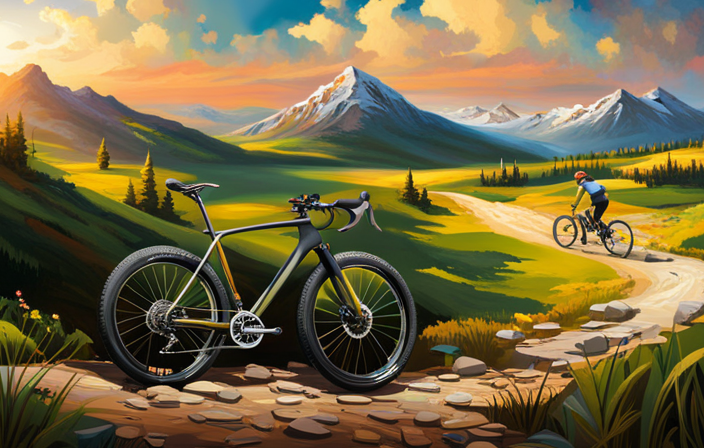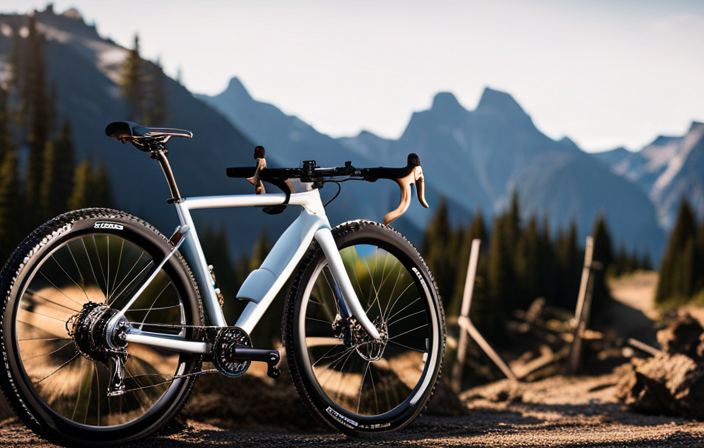Picture this: You’re out cruising on your gravel bike, effortlessly handling different terrains. All of a sudden, you come across a steep incline that calls for a swift gear change.
With the Shimano 1x setup, you effortlessly transition from one gear to another, thanks to its simplified drivetrain design.
In this article, we will explore what exactly the Shimano 1x setup is and why it has become increasingly popular among gravel bike enthusiasts.
So buckle up and get ready to dive into the world of efficient and versatile cycling!
Key Takeaways
- Simplified shifting system with one front chainring
- Increased chain retention with narrow-wide teeth
- Eliminates the need for a front derailleur
- Lighter weight for improved performance
The Basics of a 1x Drivetrain
You’ll want to familiarize yourself with the basics of a 1x drivetrain for your gravel bike. The term ‘1x’ refers to having only one front chainring, as opposed to the traditional setup of two or three front chainrings. This simplified shifting system offers several advantages for off-road riding.
One of the main benefits of a 1x drivetrain is simplified shifting. With fewer gears to worry about, you can focus more on your ride and less on gear selection. Shifting becomes intuitive and easy, allowing you to quickly respond to changes in terrain without any confusion.
In addition, a 1x drivetrain provides increased chain retention. The single front chainring is designed with narrow-wide teeth that help prevent the chain from dropping off during rough descents or bumpy sections. This enhanced stability ensures a smoother and more reliable ride.
Moving forward into the next section about the advantages of the Shimano 1x setup, it’s important to note that Shimano has been at the forefront of developing high-quality components for gravel bikes. Their 1x drivetrains offer not only simplified shifting and increased chain retention but also excellent durability and precise performance.
Advantages of the Shimano 1x Setup
The Shimano 1x setup offers several advantages over traditional drivetrain systems.
Firstly, it provides simplified shifting, allowing for quick and precise gear changes with just one lever. This eliminates the need for a front derailleur, simplifying the overall system and reducing potential maintenance issues.
Secondly, the 1x setup offers increased chain retention, thanks to an integrated chainring and narrow-wide tooth profile that prevents chain drops even on rough terrain.
Lastly, the use of fewer components in a 1x drivetrain results in a lighter weight overall, making it ideal for gravel bike applications where weight savings can be crucial.
Simplified Shifting
When using a Shimano 1x setup on a gravel bike, shifting becomes much simpler. The advantages of simplified shifting are numerous and can greatly enhance your riding experience.
Here are some tips for smooth gear changes:
-
Ensure proper cable tension: Proper cable tension is crucial for smooth shifting. Adjust the tension as needed to ensure precise and reliable gear changes.
-
Use the correct chainring size: Choosing the appropriate chainring size can optimize your gear range and improve shifting performance.
-
Maintain clean drivetrain components: A clean drivetrain reduces friction and allows for smoother shifts.
By following these tips, you can enjoy the advantages of simplified shifting with your Shimano 1x setup.
Now let’s explore another key benefit of this system – increased chain retention.
Increased Chain Retention
One of the key benefits of a Shimano 1x system is increased chain retention. This means that the chances of the chain dropping off the front chainring are significantly reduced. With a single front chainring and a narrow-wide tooth profile, the chain is held in place more securely, even on rough terrain or during aggressive riding. The improved chain retention enhances the overall reliability and stability of the drivetrain and contributes to improved shifting performance.
With better chain retention, there is less chance of any skipping or slipping when shifting gears, resulting in smoother and more precise gear changes. This ensures that power transfer remains consistent and efficient throughout your ride. Moreover, by eliminating the need for a front derailleur, Shimano 1x setups reduce weight and complexity while maintaining excellent performance.
Moving on to lighter weight…
Lighter Weight
To lighten your bike, you can opt for a 1x system, which reduces the weight by eliminating the front derailleur. The Shimano 1x setup for a gravel bike offers a range of maintenance tips and upgrading options to further enhance its lightweight performance.
Firstly, regularly clean and lubricate your drivetrain to ensure smooth shifting and extend the lifespan of your components.
Secondly, consider upgrading to lighter chainrings made from materials like aluminum or carbon fiber. These options not only reduce weight but also increase durability.
Additionally, choosing the right chainring size is crucial in maximizing efficiency without sacrificing power. Experiment with different sizes to find the perfect balance between speed and climbing ability.
Transitioning into the next section about ‘choosing the right chainring size’, it’s important to understand how this decision affects overall performance on varied terrain.
Choosing the Right Chainring Size
If you’re looking to choose the right chainring size for your Shimano 1x setup on a gravel bike, consider opting for a smaller size to ensure better climbing capabilities. When it comes to gear ratio options, a smaller chainring allows for easier pedaling and more efficient power transfer when tackling steep ascents. This is especially important in off-road conditions where maintaining traction and control is crucial.
Additionally, using a narrow-wide chainring can provide added benefits by preventing the chain from slipping off during rough rides, thanks to its teeth design that securely holds the chain in place. This ensures smoother shifting and reduces the risk of dropping the chain altogether.
Understanding the wide-range cassette is essential when choosing the appropriate chainring size for your Shimano 1x setup. The wide-range cassette refers to a cassette with a large range of gears, typically starting with an easy climbing gear and ending with a high-speed gear for flats or descents. By pairing a smaller chainring with a wider range cassette, you can achieve optimal gear ratios that cater to both climbing and speed requirements on varied terrains. With this combination, you’ll have better control over your cadence while also being able to maintain higher speeds when needed.
Transitioning into understanding the wide-range cassette helps us delve deeper into optimizing our gearing system without compromising performance or efficiency.
Understanding the Wide-Range Cassette
Understanding the wide-range cassette is crucial for optimizing your gear ratios and achieving optimal performance on varied terrains. A wide-range cassette refers to a cassette with a large number of gears, typically ranging from 10 to 12 speeds.
The benefits of a wide-range cassette are twofold: it provides a wider gear range and allows for smaller jumps between gears.
When considering gear range, it’s important to take into account the type of terrain you’ll be riding on. A wider gear range means you can tackle steep climbs with ease while still maintaining high speeds on flat sections or descents. This versatility is especially beneficial for gravel biking, where you encounter both challenging uphill sections and fast-paced downhills.
The smaller jumps between gears in a wide-range cassette provide smoother transitions when shifting, allowing you to maintain momentum and cadence without significant disruptions. This is particularly advantageous when tackling uneven surfaces or changing conditions frequently encountered in gravel riding.
In conclusion, understanding the benefits of a wide-range cassette and considering your gear range requirements based on the terrain you’ll be riding on is essential for maximizing your gravel biking experience.
Transitioning into the next section about compatibility with different terrains, it’s important to examine how this setup performs under various conditions.
Compatibility with Different Terrain
In my previous section, I explained the concept of a wide-range cassette and its benefits for gravel biking. Now, let’s delve into the compatibility of the Shimano 1x setup with different terrain.
The Shimano 1x setup offers excellent adaptability to changing weather conditions and varying terrains. Its simplicity ensures reliable performance regardless of whether you’re riding on muddy trails or dry gravel roads. This adaptability is crucial when encountering unexpected weather changes during your ride.
Moreover, the Shimano 1x setup has a significant impact on overall bike handling and stability. By eliminating the front derailleur, which can sometimes be bulky and affect maneuverability, this system provides a more streamlined design that enhances control over rough surfaces.
To give you a clearer picture, here’s a table showcasing some key features of the Shimano 1x setup in comparison to traditional multi-chainring setups:
| Features | Shimano 1x Setup | Traditional Multi-Chainring Setup |
|---|---|---|
| Simplicity | Yes | No |
| Gear Range | Wide | Limited |
| Front Derailleur | None | Present |
With such adaptability and improved bike handling offered by the Shimano 1x setup, it’s time to consider gear ratios.
Considerations for Gear Ratios
When considering gear ratios, it’s important to take into account your specific riding preferences and the terrain you’ll be tackling. Gear selection plays a crucial role in optimizing performance and climbing efficiency on a gravel bike equipped with Shimano 1x setup.
Here are four key considerations to keep in mind:
-
Terrain: Assess the type of terrain you’ll encounter frequently. Steep climbs require lower gear ratios, while flatter or rolling terrains can benefit from higher ones.
-
Cadence: Determine your preferred cadence for different riding conditions. A lower gear ratio allows for a higher cadence, which can reduce fatigue during long rides.
-
Front Chainring Size: Choosing the appropriate front chainring size is essential for achieving the desired gear range. Smaller chainrings provide easier climbing gears, while larger ones offer more speed on flats and descents.
-
Rear Cassette Range: Consider the available options for rear cassettes to fine-tune your gear ratios further. Opting for a wider range cassette provides more flexibility to tackle varying gradients.
Considering these factors will help you optimize your gear ratios based on personal preference and the demands of your intended riding terrain.
Now let’s delve into some maintenance tips for the Shimano 1x setup without skipping a beat.
Maintenance Tips for the Shimano 1x Setup
To maintain your Shimano 1x setup, it’s important to follow these maintenance tips.
- Regularly inspect your drivetrain for any signs of wear or damage. Look for bent teeth on the chainring and cassette, as well as any excessive dirt or grime buildup.
- Clean your drivetrain regularly using a degreaser and a brush to remove any accumulated dirt or debris. Be sure to lubricate the chain with a high-quality lubricant after cleaning.
Check the tension of your derailleur regularly to ensure proper shifting performance. If you notice any hesitation or skipping gears, adjust the cable tension accordingly. Additionally, keep an eye on the jockey wheels for wear and replace them if necessary.
If you encounter any issues with shifting, consult the troubleshooting guide provided by Shimano. This guide will help you identify common problems such as misalignment or cable stretch and provide step-by-step instructions on how to resolve them.
By following these maintenance tips and referring to the troubleshooting guide when needed, you can ensure that your Shimano 1x setup stays in optimal condition for smooth and reliable performance.
When considering upgrading your bike to a 1x drivetrain, there are several factors to take into account…
Upgrading Your Bike to a 1x Drivetrain
Consider upgrading your bicycle to a 1x drivetrain for improved performance and simplicity. A 1x drivetrain eliminates the need for a front derailleur and multiple chainrings, reducing weight, increasing clearance, and improving shifting reliability. Here are four key benefits of a 1x drivetrain for off-road riding:
-
Improved Chain Retention: The narrow-wide chainring design of a 1x setup prevents the chain from dropping off even on rough terrain, ensuring a more secure ride.
-
Better Gear Range: With advancements in cassette technology, you can now achieve a wide gear range with a 1x drivetrain. This allows you to tackle both steep climbs and fast descents efficiently.
-
Simplified Shifting: With only one shifter controlling all gears at the rear, shifting becomes easier and less complicated. This means fewer distractions while riding and more focus on the trail ahead.
-
Reduced Maintenance: By eliminating the front derailleur, cable routing becomes simpler and there are fewer components to adjust or replace, resulting in lower maintenance requirements.
When converting a road bike to a 1x drivetrain, consider these tips:
- Choose an appropriate chainring size based on your riding style and terrain.
- Ensure your rear derailleur is compatible with the larger cassette range.
- Adjust your chainline properly to maintain smooth shifting.
- Consider upgrading to a clutched rear derailleur for enhanced chain retention.
Transitioning into the subsequent section about recommended Shimano 1x components…
Recommended Shimano 1x Components
For an improved riding experience, you should consider upgrading to Shimano’s recommended 1x components. When choosing a chainring for your gravel bike, it is important to consider the terrain and your preferred cadence. Shimano offers a range of options, including narrow-wide chainrings that provide excellent chain retention and minimize the risk of dropping the chain on rough terrain. Additionally, Shimano’s Dynamic Chain Engagement (DCE) technology ensures smooth and reliable shifting even in challenging conditions.
When it comes to cassette compatibility, Shimano provides various options to suit different riding styles and preferences. The wide range of cassettes available allows you to choose gears that are appropriate for both climbing steep hills and cruising on flat roads. Whether you prefer a wide-range cassette with larger jumps between gears or a tighter ratio cassette for smoother transitions, there is a suitable option for every rider.
Upgrading to Shimano’s 1x components will not only simplify your drivetrain but also improve its performance and durability. With their reputation for precision engineering and attention to detail, Shimano components are known for their reliability and longevity.
Incorporating these high-quality components into your gravel bike setup will undoubtedly enhance your overall riding experience. Now let’s delve into personal experiences and testimonials from riders who have already made the switch to a 1x drivetrain configuration without skipping a beat.
Personal Experiences and Testimonials
When it comes to personal experiences and testimonials with the Shimano 1x setup for a gravel bike, I can confidently say that it has been a game-changer for me. The simplicity and efficiency of this setup have greatly enhanced my riding experience.
One of the standout features of the Shimano 1x setup is its versatility. With various upgrading options available, you can easily customize your drivetrain to suit your specific needs and preferences. This flexibility allows you to optimize your gear range for different terrains, ensuring that you always have the right gear ratio at your disposal.
In terms of bike handling, the Shimano 1x setup has had a noticeable impact. The elimination of front derailleur and multiple chainrings not only reduces weight but also improves shifting performance. The simplified drivetrain design provides a more streamlined look to the bike while offering crisp and precise shifting even in challenging conditions.
To help you visualize the impact of upgrading to a Shimano 1x setup on your gravel bike’s performance, here is a table showcasing some key differences:
| Aspect | Traditional Drivetrain | Shimano 1x Setup |
|---|---|---|
| Weight | Heavier | Lighter |
| Gear Range | Limited | Customizable |
| Shifting | Less precise | Crisp |
| Bike Appearance | Cluttered | Streamlined |
With its numerous advantages, it’s no wonder that many gravel riders are making the switch to the Shimano 1x setup. In the next section, we will compare this configuration to other drivetrain options available in the market.
Comparison to Other Drivetrain Configurations
The Shimano 1x setup outperforms other drivetrain configurations in terms of weight, gear range, shifting precision, and bike appearance.
When comparing the 1x setup to other drivetrain configurations like the traditional 2x or even the newer 2x compact setups, there are several benefits that make it the preferred choice for gravel biking.
Firstly, the weight advantage of a 1x setup cannot be ignored. By eliminating the front derailleur and chainring, you can significantly reduce the overall weight of your bike. This makes a noticeable difference when climbing steep grades or navigating technical terrain.
Secondly, the gear range offered by a 1x setup is impressive. With Shimano’s wide-range cassettes and narrow-wide chainrings, you can easily find a suitable gear for any situation on gravel roads. The simplicity of having only one chainring also results in improved shifting precision and reliability.
Additionally, the clean and sleek appearance of a 1x setup adds to its appeal. Without cluttering up your bike’s cockpit with multiple shifters and cables, you get a more streamlined look that exudes efficiency.
In conclusion, when compared to other drivetrain configurations, the Shimano 1x setup shines in terms of weight savings, gear range versatility, and overall performance.
Now let’s explore some expert tips for optimizing performance without sacrificing durability or comfort during your gravel rides.
Expert Tips for Optimizing Performance
To optimize your performance on gravel rides, try implementing these expert tips.
When it comes to gear ratio selection for a Shimano 1x setup on a gravel bike, it’s important to find the right balance between having enough low gears for climbing and enough high gears for fast descents or flat sections. The key is to choose a gear range that suits both your riding style and the terrain you’ll be encountering.
One way to optimize power transfer with a Shimano 1x setup is by fine-tuning your cadence. Maintaining an efficient cadence can help you generate more power while also reducing fatigue. Experiment with different cadence ranges to find what works best for you on gravel surfaces.
Another tip is to pay attention to chainline alignment. Properly aligning the chainline can minimize unnecessary friction and ensure smooth shifting throughout your ride. This involves adjusting the position of the front and rear chainrings so that they are in line with each other.
Lastly, consider investing in lightweight components, such as carbon fiber cranks or cassette upgrades, which can further enhance performance by reducing weight and improving overall efficiency.
By following these expert tips for optimizing power transfer and gear ratio selection with a Shimano 1x setup on a gravel bike, you’ll be well-equipped to tackle any terrain with confidence and ease.
Moving onto common misconceptions about the Shimano 1x setup…
Common Misconceptions about the Shimano 1x Setup
Contrary to popular belief, there are some common misconceptions about the Shimano 1x setup. One of the most prevalent myths is that a single chainring limits gear range and hinders performance. However, this is not entirely true.
The Shimano 1x setup actually offers a wide range of gears, thanks to its cassette options with larger sprockets. These cassettes can provide similar or even greater gear ratios compared to traditional double chainring setups.
Another misconception is that the Shimano 1x setup compromises shifting accuracy and efficiency. In reality, Shimano has developed advanced technology such as their Shadow RD+ rear derailleur, which ensures precise and reliable shifting even on rough terrain. Additionally, the absence of a front derailleur eliminates the risk of chain drops and simplifies maintenance.
Advantages of the Shimano 1x setup include reduced weight due to fewer components, improved ground clearance for tackling off-road obstacles, and enhanced simplicity for easier operation. However, it also has some disadvantages like limited fine-tuning options for cadence optimization.
In conclusion, debunking these myths reveals several advantages of the Shimano 1x setup while acknowledging its limitations as well. Now let’s move on to discuss the pros and cons of this popular gravel bike configuration without missing a beat.
Pros and Cons of the Shimano 1x Setup
When considering the pros and cons of using a 1x drivetrain, you’ll find there are several factors to consider.
One of the main advantages of the Shimano 1x setup is its simplicity. With just a single chainring at the front and a wide-range cassette at the rear, there are fewer components to worry about and maintain. This not only reduces weight but also makes shifting smoother and more reliable.
Another benefit of the Shimano 1x setup is improved chain retention. The narrow-wide tooth profile on the chainring helps prevent chain drops, ensuring a secure and efficient power transfer. Additionally, with a wider gear range available on modern cassettes, you can still find suitable ratios for both climbing steep gradients and reaching high speeds on flat sections.
However, there are some considerations when choosing your chainring size for optimal performance. Smaller chainrings provide easier climbing gears but may limit your top-end speed. On the other hand, larger chainrings offer higher top speeds but require more effort for climbs or riding in hilly terrain.
In conclusion, the Shimano 1x setup offers simplicity and improved chain retention while providing a wide gear range for various terrains. When deciding on your gear ratio considerations, it’s important to strike a balance between climbing ability and top-end speed based on your riding preferences and local terrain conditions. Transitioning into our final thoughts section…
Conclusion and Final Thoughts
In conclusion, the Shimano 1x setup for a gravel bike has its fair share of advantages and disadvantages. On the positive side, it offers simplicity, lighter weight, improved chain retention, and better ground clearance.
However, there are also some drawbacks to consider. When it comes to upgrading options, the Shimano 1x setup may have certain limitations. Since it uses a single chainring at the front, you might not have as many gear ratios to choose from compared to a traditional 2x or 3x setup. This could be a concern if you frequently ride on varying terrains or if you prefer having more options for different riding conditions.
Additionally, while the Shimano 1x setup is generally reliable and efficient, there is always a potential risk of dropped chains when tackling rougher terrain or engaging in aggressive shifting. This can be mitigated by using chain guides or clutch derailleurs that provide extra tension and stability.
Overall, if you prioritize simplicity and weight savings over having an extensive range of gear ratios or encounter extremely technical and unpredictable off-road conditions regularly, then the Shimano 1x setup could be a suitable choice for your gravel bike.
Frequently Asked Questions
Can the Shimano 1x setup be used for road biking, or is it only suitable for gravel bikes?
The Shimano 1x setup can indeed be used for road biking, although it is more commonly found on gravel bikes. The benefits of a 1x drivetrain for gravel biking include simplicity, improved chain retention, and reduced weight.
However, for road biking, the advantages of a 2x drivetrain are apparent. A 2x setup allows for a wider range of gear ratios, which is important for maintaining optimal cadence and speed on varying terrain.
Are there any specific chainring sizes that are recommended for different types of terrain?
Recommended chainring sizes for a 1x setup on different terrains vary depending on the rider’s preferences and fitness level. Generally, smaller chainrings like 38 or 40 teeth are suitable for steep climbs and off-road trails, providing easier gearing ratios.
For flatter terrain or road riding, larger chainrings such as 44 or 46 teeth offer more top-end speed.
The advantages of a 1x setup include simplified shifting, reduced weight, improved mud clearance, and increased durability due to fewer components.
Is it possible to switch back to a 2x drivetrain if I don’t like the Shimano 1x setup?
Switching back to a 2x drivetrain from a Shimano 1x setup is possible, but it comes with its own set of pros and cons.
One interesting statistic to consider is that the majority of professional gravel racers are now using 1x drivetrains.
Comparing 1x vs 2x drivetrains, the advantage of a 1x setup is simplicity, lighter weight, and improved chain retention. However, a 2x drivetrain offers more gear range options for varying terrain and cadence preferences.
Ultimately, the decision depends on your personal riding style and terrain preferences.
How often should I clean and lube the components of a Shimano 1x setup?
To properly clean and maintain a Shimano 1x setup, it is recommended to clean the drivetrain after every ride or at least once a week.
Start by removing the chain and cassette using specific tools. Clean them thoroughly with degreaser and a brush, then rinse and dry before reassembling.
Lubricate the chain with a high-quality lubricant designed for bike chains.
Additionally, to improve shifting performance on a Shimano 1x setup, ensure that the derailleur hanger is aligned properly and adjust cable tension if necessary.
Are there any known issues or common complaints about the Shimano 1x setup that I should be aware of before making the switch?
Common issues with the Shimano 1x setup include chain drops and poor chain retention, especially in rough terrain. To address these concerns, regular maintenance is recommended.
Cleaning and lubricating the components should be done after every ride to ensure smooth operation. Additionally, it’s crucial to periodically check for wear on the chainring teeth and replace them if necessary.
Proper adjustment of the derailleur is also essential to prevent shifting issues.
Conclusion
In conclusion, the Shimano 1x setup for a gravel bike offers numerous advantages for riders seeking simplicity and versatility. With its wide-range cassette and ability to handle varied terrains, this drivetrain system ensures smooth shifting and efficient power transfer.
By choosing the right chainring size and following expert tips for optimization, riders can enhance their performance on the trails. Despite some misconceptions, the Shimano 1x setup is a reliable choice with both pros and cons to consider.
So why not give it a try and experience the benefits firsthand?
















